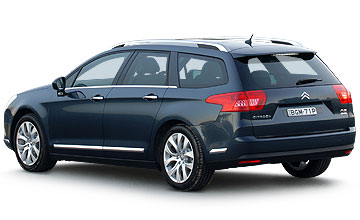BY MARTON PETTENDY | 5th Sep 2008

This time around the C5 sedan is just that – a four-door with a boot rather than a five-door with a liftback – and Citroen says its decision to go all-diesel with the MkII C5 was made easy by the fact 85 per cent of the previous model’s sales were oil-burners.
So while Citroen has made concessions by positioning its once top-selling (in Australia) model more closely to its German rivals, the new C5 still stands out from the mid-size Euro crowd with its sleek but still slightly eccentric new styling, its all-diesel engine line-up and the heritage of a historic marque whose founder invented the front-engined, front-drive and monocoque-chassis configuration used almost exclusively by small cars today.
Citroen’s following goes back a long way in Australia too, with an 85-year representation that makes it the longest continuously available car brand here.
Over that time, the French brand has established itself as a maker of some of the finest-riding and most ergonomic vehicles ever produced, thanks to its now-unique employment of hydro-pneumatic suspension and attention to occupant comfort.
The newest C5 continues these traditions. Based on Citroen’s $100,000-plus C6 flagship, it delivers new-found levels of handling dynamics, thanks to more firmly tuned spring/damping units that increase roadholding and agility without sacrificing the plush ride quality of its forebears.
There are also vast improvements in the areas of structural rigidity, noise suppression and overall refinement. The new C5 cabin is literally whisper-quiet, with the new twin-turbo diesel V6 barely audible from within the highly ergonomic passenger cell, and even the carryover 2.0 HDi diesel seeming to present a more distant thrum than before.
Only the thump of the nitrogen-filled suspension bellows over large road holes and bumps detracts from the interior’s impressive serenity. Citroen makes much of its efforts to quell noise by producing a slippery bodyshell and underbelly and wind noise is certainly better suppressed than tyre noise, which is also well isolated.
Dull steering remain the C5’s Achilles heel, however, as it lacks both the response and feedback of the most accomplished premium mid-sizers like the BMW 3 Series and Mercedes-Benz C-class, as well as more direct rivals like the Ford Mondeo, VW Passat, Renault Laguna, Peugeot 407 and even top-spec versions of the Mazda6, Honda Accord Euro and Subaru Liberty.
The numb steering feels particularly at odds in Sport suspension mode, which sharpens all of the new model’s improved dynamics ever so slightly, and firmly stamps the new C5 as a luxury, rather than sports, sedan. There’s also a degree of bump steer evident when mid-corner bumpers are struck at speed.
Interior comfort and ergonomics remain highlights, however, with a massive range of power adjustment for both of the well-shaped front seats (the driver’s massage function is neat, too), an array of well-placed controls and plenty of leg, should and (especially) headroom for both front and rear occupants.
But we’re still undecided about the fixed-hub steering wheel that migrates upwards from the C4 and, as Citroen claims, allows a plethora of controls to be placed closer to the driver, as well as accommodating a larger, non-asymmetric driver’s airbag that should provide better crash protection.
We found it easy to inadvertently operate some of the controls on the oversized fixed steering wheel hub (especially the right-side thumb wheel, which changes radio stations when in audio mode), and many of them can’t be used on twisty roads without removing a hand from the tiller, which defeats its purpose.
That said, it’s probably still more useful than a conventional steering wheel, apart from being a great point of difference for bench-racing C5 owners.
Of course, the full gamut of safety features is also present, including a driver’s knee airbag and a top-quality stability/traction control system, but rear side airbags are standard only in Exclusive variants.
While we’re complaining, the glovebox is laughably small and occupied mostly by the fuse box (though the driver is compensated somewhat by a smaller right-side dash compartment), there are no bonnet struts (which we find strange at this price level) and no steering wheel shift paddles. Even Citroen’s C4 EGS and Picasso people-mover get the latter.
The latter would still be a welcome feature, even if the two diesel engines are no fireballs – despite the fanfare that surrounds the C5’s first twin-turbo diesel V6. Smoother, more flexible and better-matched to the intuitive six-speed auto than the 2.0 HDi engine, the 2.7-litre V6 turbo-diesel offers effortless highway overtaking and spades of midrange torque – without being astoundingly quick.
At more the $60,000, the TTV6 C5 is not the bargain of the segment, but we did record just 8.3L/100km (surprisingly similar to the claimed figure), during a reasonably spirited drive through peak-hour Sydney traffic to the Hunter Valley and return, while the same route saw the 2.0 HDi return an even more creditable 7.7L/100km.
So the new C5 delivers impressive fuel consumption despite its satisfying performance, vastly improved dynamics despite its cosseting ride quality, and outstanding quietness, refinement and ergonomics – all wrapped in a stylish, individual design that is still different enough to attract the original C5’s clientele, plus a whole new buyer demographic.
Despite a couple of equipment oversights, a $10,000-higher $50K starting price than before and all-diesel engine line-up, the feature-packed new C5 should prove a hit with mid-sized premium vehicle buyers who value luxury more than BMW-like dynamics.